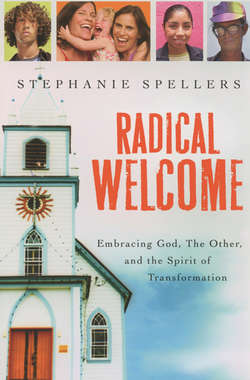Читать книгу Radical Welcome - Stephanie Spellers - Страница 13
На сайте Литреса книга снята с продажи.
Your Radical Welcome Journey
ОглавлениеHas God whispered in your ear or tugged your sleeve, urging you to step off the curb and onto this road? You’re in the right place now, especially if
• your neighborhood has changed—maybe there are more people of color or young people or poor people or lesbian, gay, bisexual, and transgendered people—and while you want to do the “right” thing, you have no idea where to start.
• you are one of The Others within a congregation, and you hope to spark or nurture your community’s commitment to transformation and find nourishment so that you can persevere.
• your church and area are homogeneous (or seem to be), but you still feel called to radical welcome as a spiritual practice—one that trains and stretches your heart to receive more of God, to surrender to the surprising, transforming movement of the Holy Spirit—and you want to find those opportunities to say “yes” to God and to The Other.
• you want to learn the basic language of radical welcome and wrap your mind and tongue around a term that’s getting more airplay everyday.
• you hope to move deeper, to get grounded in the biblical and theological issues surrounding and supporting radical welcome and perhaps to share those foundational insights with others in your congregation and community.
• you know you want to see your church become radically welcoming, but you could use some concrete examples and inspiring images of other congregations that have walked this road for a while, to see for yourself how it works.
• you’re ready to cast your own radically welcoming vision, to imagine in Technicolor what would happen at your church if you embraced fresh words, voices, songs, and faces, all standing alongside the wise, revered traditions and voices that have grounded your church’s identity so far;
• or you’ve already begun the journey toward radical change, but now you need to reckon with your history, fear (your own and others’), complacency, or a host of other challenges along the way.
This book is far more than a how-to guide for quickly achieving those goals. Rather, in the chapters that follow, I invite you to be part of a journey. Along the way, we will consider the biblical and theological foundations for radical welcome, explore vivid pictures of the dream come to life in several communities, and the resources people engaged in the work told me they found most essential—and hardest to find. You can take it to the next level using the book’s online companion—“Bread for the Journey”—which includes exercises, Bible studies, charts, strategic planning tips, and a workshop for congregations.
As you read, examine and move forward, I hope you will be patient with yourself and your community. Please stay rooted in hope, rather than paralyzing guilt or finger-pointing (at yourself or others). Try to be honest about your story, your privilege and your fears. Don’t be afraid to keep asking, “What new thing is God calling me to be and to do?” and “What support, education, training and practices would help me to follow through on what I now imagine for myself and my congregation?” The road into new life is a long one, and this leg of the journey is designed to stretch your imagination, fuel your passion and guide you closer to God’s radically welcoming dream for us all.
1. The term radical welcome has cropped up independently in various communities over the past decade or so. I coined the phrase for my own use after colleagues demanded a concise descriptor for the broadly inclusive churches I was beginning to study. My initial project—spending four months conducting intensive, on-site research with eight congregations nationwide—was called the Radical Welcome Project.
Later, I discovered leaders at St. Bartholomew’s Episcopal Church in New York City use the same term to characterize their ministry to all God’s people, especially seekers and lesbian, gay, bisexual, and transgendered (LGBT) people. Other groups in the “welcoming congregations” movement—which seeks total inclusion for LGBT people—have expanded the idea of welcoming so that it encompasses an even broader community of outcasts. They landed at radical welcome by a natural evolutionary process.
